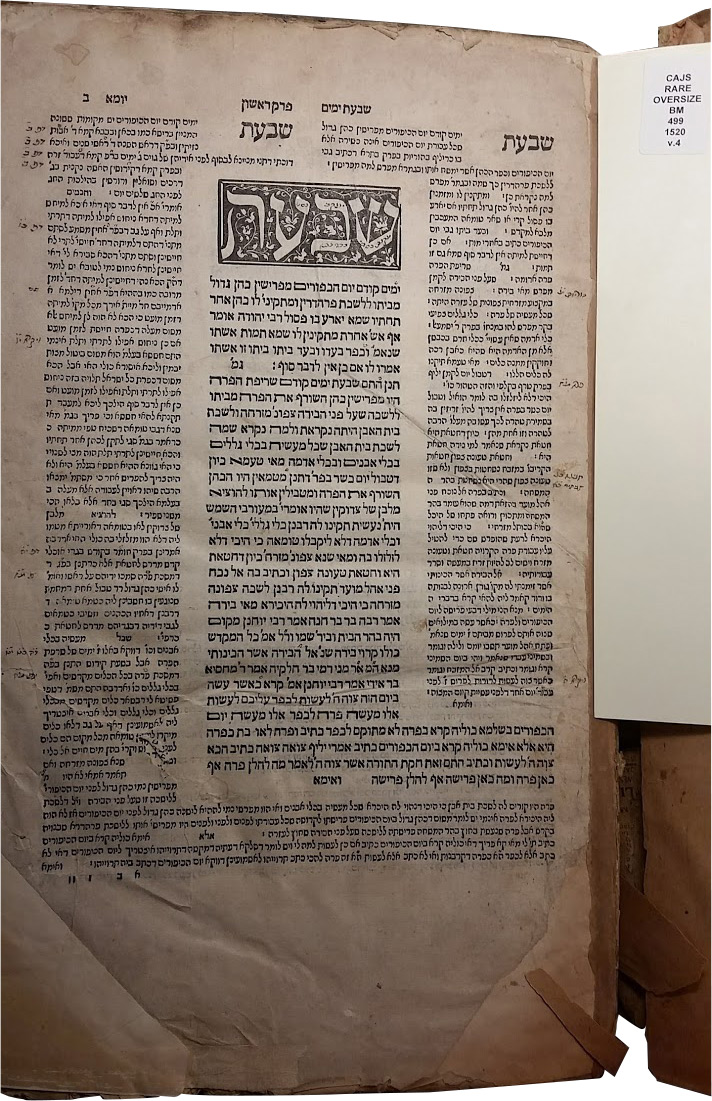Between 1519 and 1523 the first complete editions of the Babylonian and Jerusalem Talmuds were printed in Italy. An entrepreneur from Antwerp, Daniel Bomberg (b. 1483) had made a significant business decision, opening a printing house in Venice. Printed copies of the Talmuds sold well. The printing house also became a meeting place for Jews and non-Jews to share printing skills, business acumen and ideas. The strong desire on the part of Jews—some to study and some to own a material copy of the Talmud--generated the need for second, third and fourth printings. Many of the copies, which were often purchased volume-by-volume, outlived their owners, passing hands many times. They continually entered new homes, becoming increasingly valuable over time. The Library of the Katz Center for Advanced Judaic Studies has become the home to many of these Bomberg volumes, each copy with its own story, each possessing information attesting not only to the movement of Jewish books across the globe, but to individuals who owned, read, bought, sold and gifted them.
Many of the Bomberg Talmud copies owned today by the Katz Center once belonged to the great book collector and native of Philadelphia, Mayer Sulzberger (b. 1843). After his death in 1923 they found a new home in the library of Dropsie College. Due to financial strains, Dropsie became the Annenberg Research Institute in 1986 and then merged with Penn in 1993, becoming the Center for Judaic Studies. It was renamed the Center for Advanced Judaica Studies in 1998, and now is the Herbert D. Katz Center for Advanced Judaic Studies.
The copy of Masekhet Yoma displayed here took a different path from Sulzberger’s collection. It came from the personal library of Samuel Tobias Lachs who was a professor of Religion at Bryn Mawr College for most of his career. He received his AB from the University of Pennsylvania in 1946 and his PhD from Dropsie College in 1958. Upon his death in 2000, his wife, G. Phyllis Lachs, presumably because of her husband’s connection to Penn and Dropsie, donated some of her husband’s most valuable books to the Katz Center. Included was this copy of Yoma, several other volumes of the Bomberg Talmud as well as Lachs’ unfinished scholarly works.
In its new home, Lachs’ copy of Yoma connects us to his life, his love of Jewish books, and to his devotion to scholarship in the field of rabbinics. It is also a testament to the fact that Jewish Studies has found a home at major research universities, building scholarly communities around the availability of valuable resources. The care that has been taken to preserve this copy of Maskekhet Yoma, including the clues to its past homes, is evident in a note found inside its pages with the name of Abraham Moses Luncz. It is not clear whether Lachs and Luncz had a familial relationship, nor can we be sure that this copy of Yoma was in Luncz’s possession. However, this piece of paper brings us to the home of Luncz, another book lover who lived in Jerusalem from 1868 until his death in 1918. He ran a printing press during his lifetime. An article written about him in the Jewish Encyclopedia reports that in 1904 he was involved in printing an edition of the Jerusalem Talmud, a sure reflection of his interest in Jewish books and a sign that he might have owned this volume of Yoma.
This copy of Yoma is only one example of the many books at the Katz center, each with a history waiting to be told. As a present co-director of a recent collaborative digital humanities project that tracks the pathways of copies of Jewish books, Footprints: Jewish Books through Time and Place (https://footprints.ctl.


